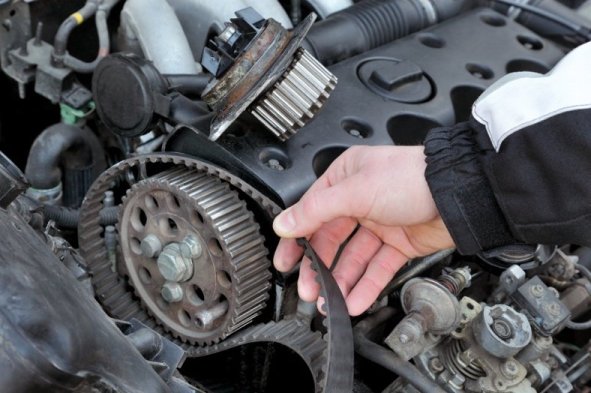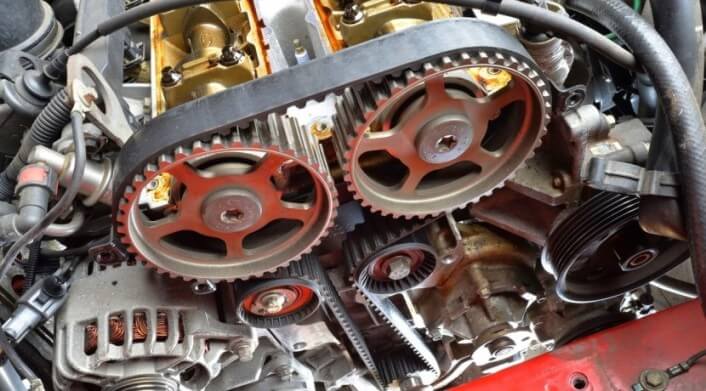Advice for timing belt replacement
The breakage of the timing belt is one of the most expensive breakdowns that car owners can encounter. Unlike easier repairs such as changing the battery or changing a wheel, it sometimes happens that these timing belt replacements are so expensive that some owners decide not to fix it due to the collateral damage caused by the belt breaking. And above all, as they say, because “the belt costs more than the dog”. But on many other occasions they could have been avoided.
How to know when to replace timing belt?
Normally, when your car has problems with the timing belt, it arises without giving a signal or any indication by which it can break. It does not emit any disturbing sound. When the timing belt breaks, the car suddenly stops immediately after a very loud sound. After that, you cannot restart your vehicle anymore.
Controls the mileage and age of the timing belt
Monitor the mileage and life time of the belt
The manufacturer of your vehicle will recommend a maximum mileage that you must travel before changing the belt (which will range between 60,000 and 160,000 km, approximately). In case we move frequently in urban environments we should shorten this mileage by 20%, since the belt is “working” even if the car does not travel kilometers (for example in traffic jams, traffic lights, pedestrian crossings, etc.).
A clear example: if the manufacturer says that it is necessary to change the belt every 120,000 km, it is not the same to cross them in 6 speed to 2,000 RPM by highway at 120 km/h that to cross them in city along thousands of kilometers start-stop without moving of the 4 speed in short trips.
Do you need to change the timing belt every few years?
The car manufacturer will also recommend a maximum belt change time. In case of not indicating it, every 5 years it would be advisable to change it or at least check it thoroughly and at the least symptom of fatigue (cracks, obvious discoloration, notches, wear, etc.) change it. A belt can reach 7 to 10 years with guarantees, but we must control its status.
Driving in demanding conditions: if we move a lot in urban environment (for example, taxi drivers, daily commute to work, etc.) or in extreme climates (very cold (-10ºC), very hot (+30ºC), very dusty, off road, very wet, etc.), we should check or change the belt every 4 years. If the 4 years are not met, we must also control the kilometers and reduce the figure recommended by the manufacturer by 20%.
Considerations to take into account
- Belt tension: The timing belt must be correctly tensioned, so we must monitor the health of the tensioner. If we hear some rhythmic noise “that you could not hear before” when the car is idling or when accelerating in neutral with the car stopped, it is possible that some tensioner is touched. If we are not able to find out the origin of the noise, we should take the engine to check.
- Caution with the water pump: In many modern cars the water pump is also carried by the timing belt. We have found several times a breakage of the distribution caused by a simple breakdown of the water pump (seizure, clearances, etc.). If your car is like this, always demand that you change the water pump at each change of the timing belt. The pump can be good and endure the whole life of the car, but if it is not, you will regret not having paid the 50 euros that a new pump costs. Also, if before arriving at the belt change we see refrigerant leaks, do not hesitate to bring your car for check it just in case.
Distribution chain
Some cars instead of a strong timing belt carry a distribution chain. At the time of buying the car, it is possible that the dealership salesman tries to “sell the motorcycle” saying that the chain is indestructible, etc. Some manufacturers recommend periods of change of more than 200,000 km.
It is true that the chain has its advantages, especially in terms of reliability, but we must not forget it either, since the tensioner is subject to much more effort and wear, needing surveillance. In addition, although the chain barely wears out, it can go “stretching”, which causes it to lose tension and become noisier, and can cause a collapse. This happens more frequently especially when the driver is fond of carrying the high-revving engine. If we hear a “tinkle” when the engine is idling, we should take the car to check urgently.
How much does it cost to change the timing belt?
There is no “standard” price for the timing belt replacement, since it depends a lot on the car and engine in question. We are talking about a job that can range between 300 and 1,000 euros for a “normal car”, since the price of the kit and the quantity of required labor is very variable.
The price for breakage of the timing belt
If the damage occurs and the distribution is out of point, we will most likely destroy part of the engine. By interfering with the movement of the valves with the movement of the pistons. It is a lottery and the breakdown can be from “small thing” until a price of 6,000 euros, depending on the type of engine and luck that we have.
On average, the damage is usually between 1,500 and 2,000 euros, so it is to take into account.
Timing belt vs chain
Whether a car assembles a distribution chain or not is due more to a question of design and costs for the manufacture of the engine, than for reasons of reliability of one system or another. Both are completely valid today, because just as the belt needs to be replaced every six kilometers, the chain also needs to maintain a series of elements in perfect condition.
However, both the chain and the timing belt present a series of advantages and disadvantages that can decline the purchase of a vehicle to one side or the other.
The advantages of the timing belt are:
- Cost savings for the brand. Making the belt is much cheaper than the chain, so it is an element that companies value when designing and manufacturing their engines.
- Noise. The belt is in continuous friction with the metallic pinions to which it is attached so that being composed mostly of rubber, noise transmission is less problematic.
The advantages of the distribution chain are:
- It is very unlikely that a chain will break, because being made of metal has a greater durability.
- Maintenance. A chain needs no maintenance other than checking that the tensioner is in good condition and little else. In any case, and only in some models, it can replace the 250 thousand kilometers, but only as a preventive measure.
The disadvantages of the timing belt are:
- Possibilities of breakage. The belts, despite being made with resistant materials, are not immune to wear and tear, so their useful life will depend on their quality.
- Precisely because they are elaborated in a material that degrades they have to be replaced. The moment in which this operation has to be carried out will depend on the engine and manufacturer, but there are few models that exceed 120 thousand kilometers without needing to change this element.
The disadvantages of the distribution chain are:
- Just as the belt needs to be changed, the chain tensioner can present wear and consequently cause slack. This problem usually appears when the vehicle has traveled, at least 250 thousand kilometers, and it is solved by changing the tensioner and adjusting the chain.
- The frictional noise of the chain is greater than that of the belt by the materials that form it. This sound, if the engine is badly soundproofed, will be evident (not annoying), so its solution is to incorporate more sound-absorbing material.
Which cars do not have a timing belt
Until the late eighties, most cars used to move the camshafts and the water pump distribution chain. However, as the development costs of the engines increased, brands decided to replace them to reduce costs. This reason was never explained as such, but if other reasons came out as its lower timing belt noises or lightness with respect to the chain.
However, the counterpart of using a belt, instead of a chain, was that they had to be replaced and that their cost would not be precisely low (in a change of timing belt will include other parties such as the water pump). Therefore, while the brands reduced the balance of costs in manufacturing, they increased the income by steps in the workshop.
However, over the years, some brands have returned to rescue the distribution chain for some of its engines. Elaborate a list of models that incorporate this system would be very complex, because more and more are the engines that include it and are associated with several models of one or several brands.

